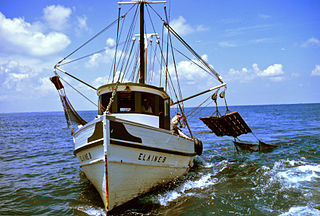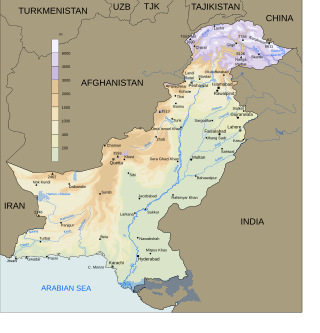
Fishing is the activity of trying to catch fish. Fish are often caught as wildlife from the natural environment, but may also be caught from stocked bodies of water such as ponds, canals, park wetlands and reservoirs. Fishing techniques include hand-gathering, spearing, netting, angling, shooting and trapping, as well as more destructive and often illegal techniques such as electrocution, blasting and poisoning.

Plantations are farms specializing in cash crops, usually mainly planting a single crop, with perhaps ancillary areas for vegetables for eating and so on. Plantations, centered on a plantation house, grow crops including cotton, cannabis, coffee, tea, cocoa, sugar cane, opium, sisal, oil seeds, oil palms, fruits, rubber trees and forest trees. Protectionist policies and natural comparative advantage have sometimes contributed to determining where plantations are located.

Chimbote ; Quechua: Chimputi) is the largest city in the Ancash Region of Peru, and the capital of both Santa Province and Chimbote District.

The fishing industry includes any industry or activity that takes, cultures, processes, preserves, stores, transports, markets or sells fish or fish products. It is defined by the Food and Agriculture Organization as including recreational, subsistence and commercial fishing, as well as the related harvesting, processing, and marketing sectors. The commercial activity is aimed at the delivery of fish and other seafood products for human consumption or as input factors in other industrial processes. The livelihood of over 500 million people in developing countries depends directly or indirectly on fisheries and aquaculture.
The agricultural history of Peru includes agriculture, cultivation of plants and herbs and general changes in the history of farming in Peru or its historical regions.

Commercial fishing is the activity of catching fish and other seafood for commercial profit, mostly from wild fisheries. It provides a large quantity of food to many countries around the world, but those who practice it as an industry must often pursue fish far into the ocean under adverse conditions. Large-scale commercial fishing is called industrial fishing.

Ilo is a port city in southern Peru, with 66,118 inhabitants. It is the second largest city in the Moquegua Region and capital of the Ilo Province.
Agriculture and aquaculture in Hong Kong are considered sunset industries. Most agricultural produce is directly imported from the neighbouring mainland China. In 2006 the industry accounts for less than 0.3% of the labour sector. Geographically Hong Kong consists largely of steep, unproductive hillside. The local aquaculture industry is also facing challenges from competition with imported aquatic food products and concern of fish and seafood safety.

Agriculture, forestry, and fishing form the primary sector of industry of the Japanese economy together with the Japanese mining industry, but together they account for only 1.3% of gross national product. Only 20% of Japan's land is suitable for cultivation, and the agricultural economy is highly subsidized.

Drift netting is a fishing technique where nets, called drift nets, hang vertically in the water column without being anchored to the bottom. The nets are kept vertical in the water by floats attached to a rope along the top of the net and weights attached to another rope along the bottom of the net. Drift nets generally rely on the entanglement properties of loosely affixed netting. Folds of loose netting, much like a window drapery, snag on a fish's tail and fins and wrap the fish up in loose netting as it struggles to escape. However, the nets can also function as gill nets if fish are captured when their gills get stuck in the net. The size of the mesh varies depending on the fish being targeted. These nets usually target schools of pelagic fish.

Tong is a village on the Isle of Lewis, Scotland, 4 miles northeast of the main town of Stornoway on the B895 road to Back and Tolsta. The population of the village is 527. Fishing forms part of the local economy.

The fishing industry in Scotland comprises a significant proportion of the United Kingdom fishing industry. A recent inquiry by the Royal Society of Edinburgh found fishing to be of much greater social, economic and cultural importance to Scotland than it is relative to the rest of the UK. Scotland has just 8.4 per cent of the UK population but lands at its ports over 60 per cent of the total catch in the UK.

Although agriculture is the second-largest sector in the economy, Libya depends on imports in most foods. Climatic conditions and poor soils limit farm output, and domestic food production meets about 25% of demand. Domestic conditions limit output, while income and population growth have increased food consumption. Because of low rainfall, agricultural projects like the Kufra Oasis rely on underground water sources. Libya's primary agricultural water source remains the Great Man-made River (GMMR), but significant resources are being invested in desalinization research to meet growing demand. Libyan agricultural projects and policies are overseen by a General Inspector; there is no Ministry of Agriculture, per se.

China has one-fifth of the world's population and accounts for one-third of the world's reported fish production as well as two-thirds of the world's reported aquaculture production. It is also a major importer of seafood and the country's seafood market is estimated to grow to a market size worth US$53.5 Billion by 2027.
Mario Puratić was an Austro-Hungarian Empire-born American inventor who made major advances in fishing technology, such as the Puretic power block.
Agriculture in the United Arab Emirates, including fishing, was a minor part of the UAE economy in the early 1990s, contributing less than 4 percent of GDP. Since the formation of the UAE, the availability of capital and the demand for fresh produce have encouraged agricultural development. The main farming areas are Digdaga in Ras al-Khaimah. Falaj al Mualla in Umm al Qawain, Wadi adh Dhayd in Sharjah, Al Awir in Dubai and the coastal area of Al Fujairah. Total cultivable land was around 70,000 hectares as of the early 1990s.
For centuries Iceland's main industries were fishing, fish processing and agriculture. In the 19th century, 70–80% of Icelanders lived by farming, but there has been a steady decline over the years and now that figure is less than 5% of the total population. It is expected that the number will continue to fall in the future. Only 1% of the total land area is under arable cultivation, confined almost exclusively to the peripheral lowland areas of the country.

The fishing industry plays a significant part in the national economy of Pakistan. With a coastline of about 1,120 km, Pakistan has enough fishery resources that remain to be developed. Most of the population of the coastal areas of Sindh and Balochistan depends on fisheries for livelihood. It is also a major source of export earning.
Høylandsbygd is a village in Kvinnherad municipality in Vestland county, Norway. The village is located on the eastern part of the island of Halsnøya. It is one of the largest urban areas on the island, just after Sæbøvik and Eidsvik. While originally one of the island's largest farming villages, today it is renowned for its position in Norwegian shipping industry.
Melkhoutboom Cave is an archaeological site dating to the Later Stone Age, located in the Zuurberg Mountains, Cape Folded Mountain Belt, in the Addo Elephant National Park, Sarah Baartman District Municipality in the Eastern Cape Province of South Africa.












